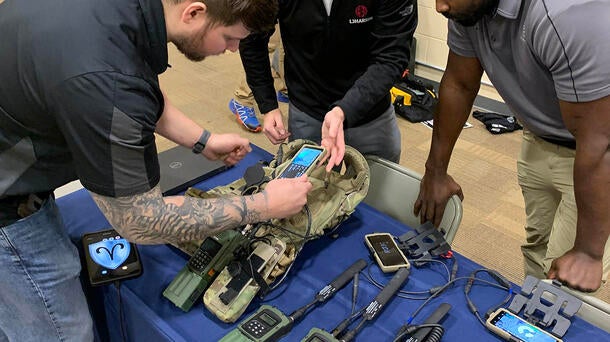As the U.S. military looks to arm small teams and individual operators at the edge of the battlefield in remote, austere environments with better access to the Internet of Things and data analytics, L3Harris Technologies and industry partners demonstrated an “unprecedented level of battlespace connectivity” for the Hyper Enabled Operator at the 75th Ranger Regiment ’s U.S. Army Ranger Tech Rodeo at Ft. Benning, Georgia, according to company officials.
L3Harris Technologies’ Communications Systems business integrated technologies across its enterprise – from advanced waveforms to multi-transport aggregation and PACE (Primary, Alternate, Contingency and Emergency) communications – to enable a totally interoperable multi-transport JADC2 network. The company and its industry collaborators demonstrated interconnected blend of permissive and non-permissive capabilities from disparate network modules operating in harmony as a cohesive, resilient ecosystem to enable cognitive overmatch and provide a full picture of the distributed, multi-domain battlespace network to a proactive, informed decision-making chain.
“This 75th Ranger Regiment inaugural event is one of many different government venues in which the U.S. defense industry can present new and disruptive technologies delivering multi-path resilience and asymmetric advantage to the U.S. military,” said Chris Aebli, president of L3Harris’ Tactical Communications business. “The flexibility of the systems-of-systems approach demonstrated at Ranger Rodeo allows the Department of Defense to rapidly adapt to new threats and provides the joint force to share the same Common Operating Picture.”
L3Harris displayed its full understanding of Special Operations Forces requirements, as a trusted U.S. Special Operations Command mission partner, during the event, leveraging its suite of radios that are interoperable between SOCOM, U.S. Department of Defense and international partners; its long-trusted night-vision, common datalink and innovative flat-panel Satellite Communications (SATCOM) solutions; and resilient transport networks with its Transport Aggregation Gateway (TAG).
Representing a real-life scenario where multi-domain data needs to move from a mobile command-and-control element to operators at the tactical edge, the demonstration sent situational awareness information from Mobile Ad Hoc Network-meshed via towers and Aries Defense cameras and Vulcane encoders to simulated Falcon® Family of Radio End User Devices, Enhanced Night Vision Goggle – Binoculars (ENVG-B) and Mission Augmented Vision Information Systems (MAVIS) via an Internet-crossing TAG linked to a receiving MANET mesh network.
In an adjacent Satellite Communications link, representing transport to higher command either in-theater or in the continental United States, the information was passed through a Panther™ II Very Small Aperture Terminal to Ku- and Ka-band satellites down to command WinTAK displays via DarkWing™ Ka-Band Flat Panel VSATs relaying the same full-motion video and Android Tactical Assault Kit Common Operating Picture information as the TAG-enabled transport.
The artificial intelligence embedded into the network also proved that the delivery of more data at faster rates did not overwhelm or put more demand on the warfighter, according to Josh Cryer, L3Harris Strategy Development principal.
A significant advance from previous demonstrations was the incorporation of ISR video right into the ENVG-B tube via the Intra Soldier Wireless network.
“Bringing the ISR video directly to the ENVG-B tube, rather than a separate system on their body, allows the operator to narrow in on what they need to see simply by moving their eyes, providing a more-immersive perspective of the battlespace,” said Cryer. “Now everyone is synched up on the same Common Operating Picture in real-time to effectively harmonize action while enhancing fratricide avoidance. At the tactical edge, the shooter is the sensor at this point, because, with all this connectivity, they’re an extension of the network – this level of connectivity on the battlespace is unprecedented.”
